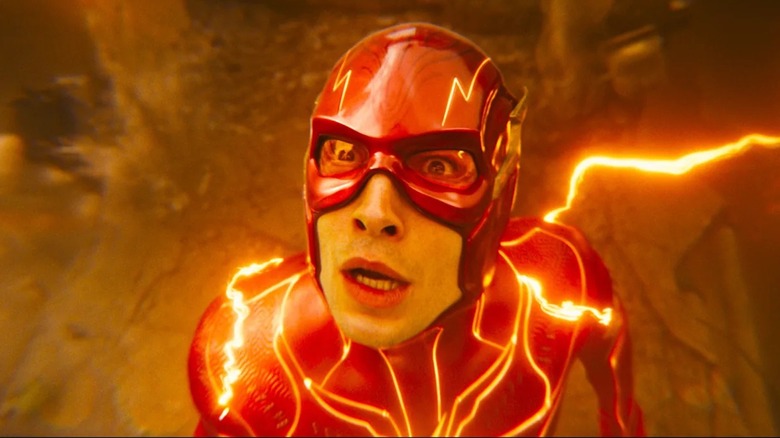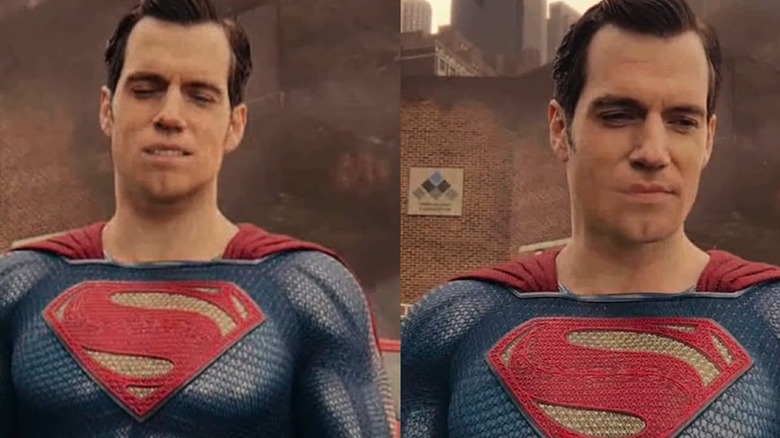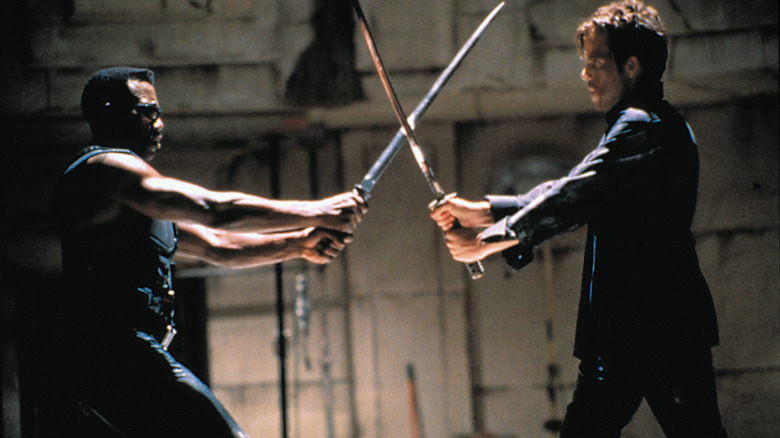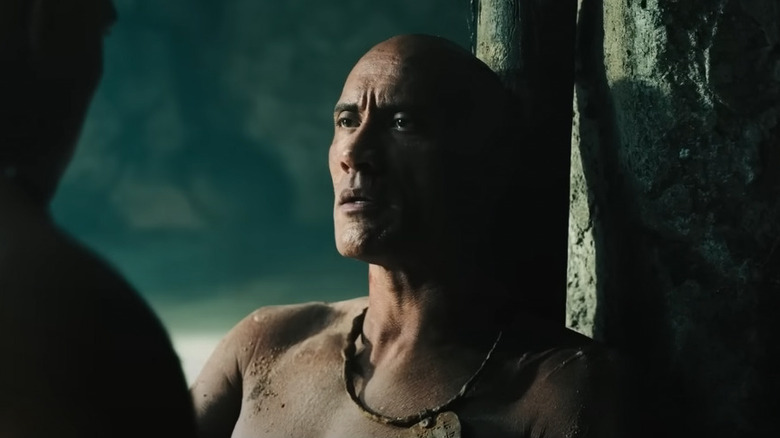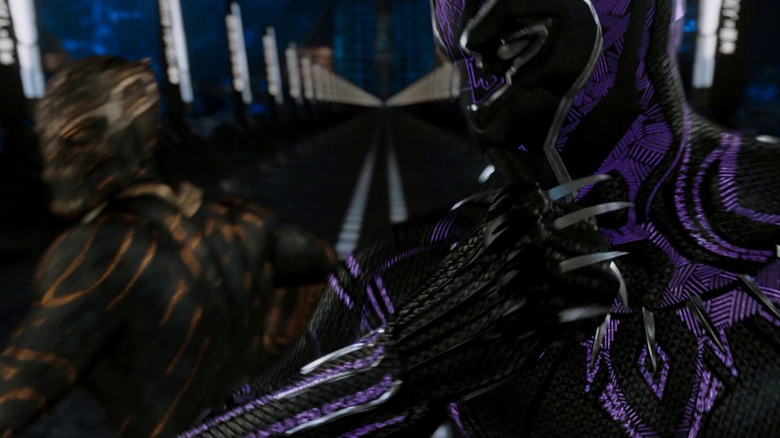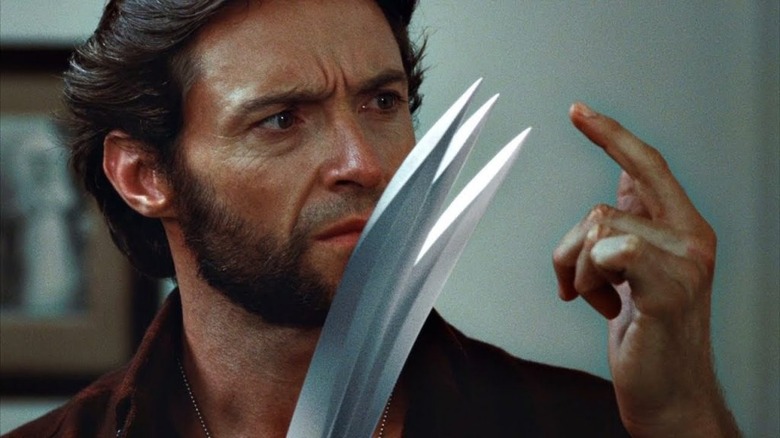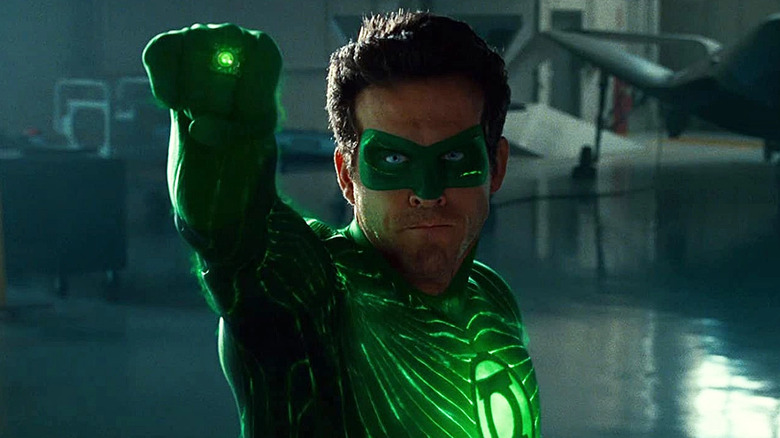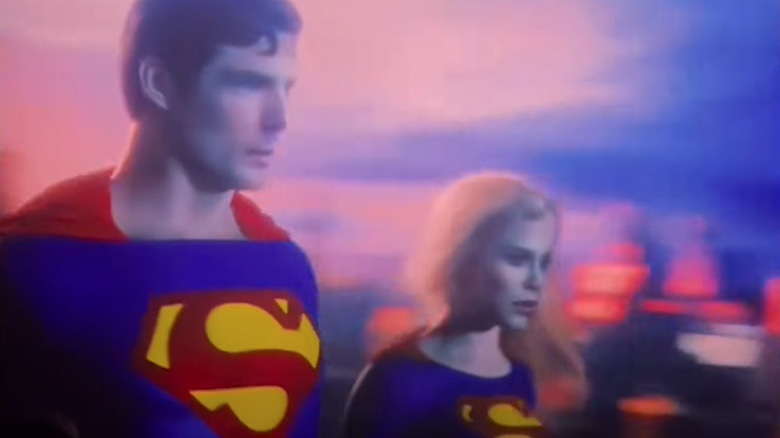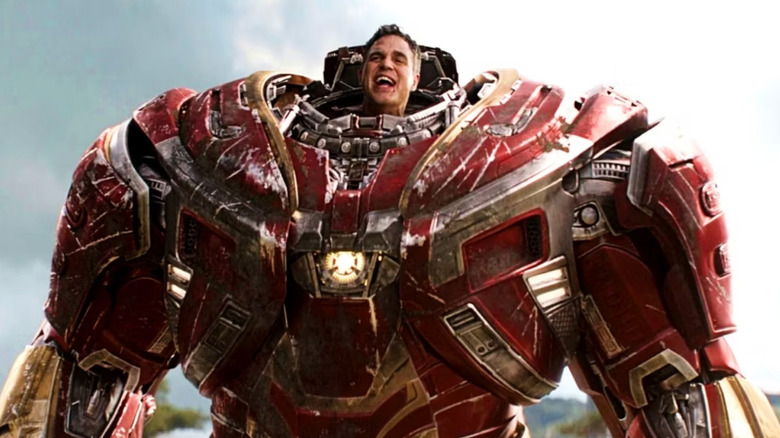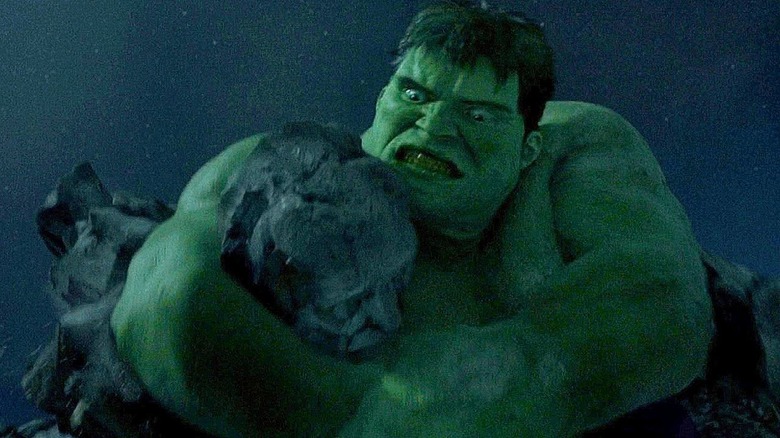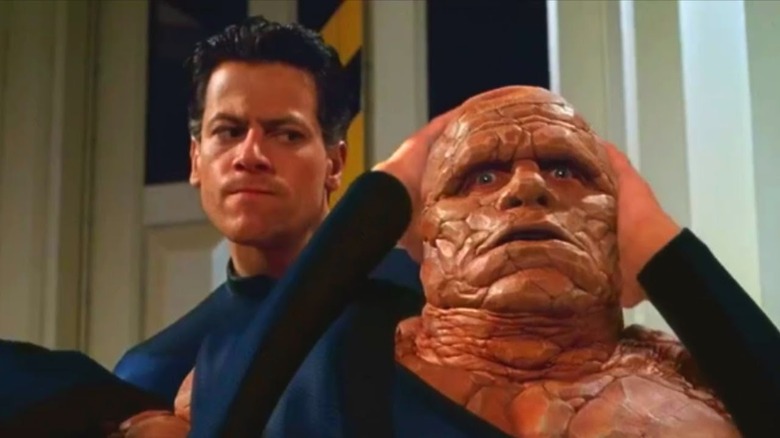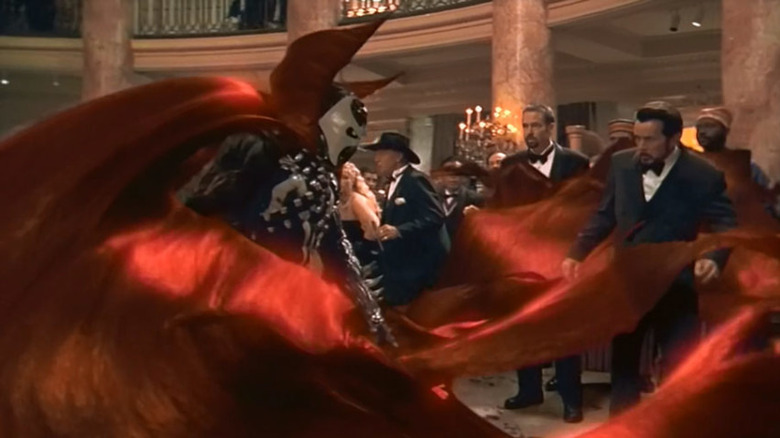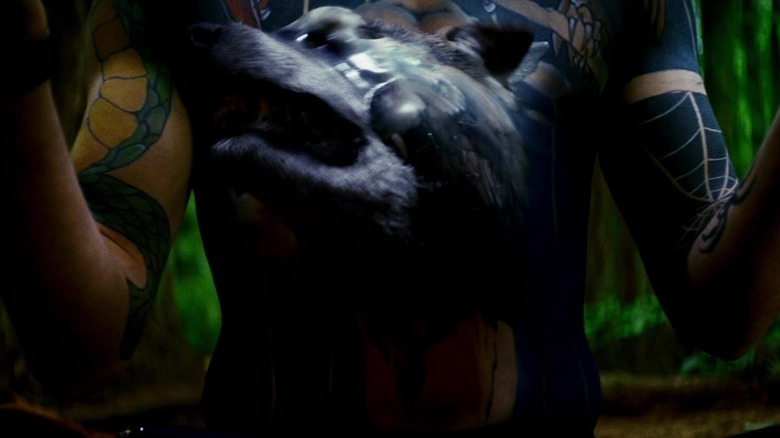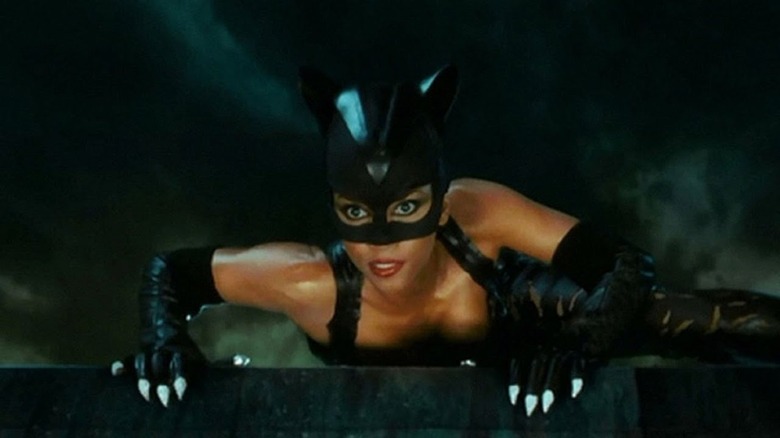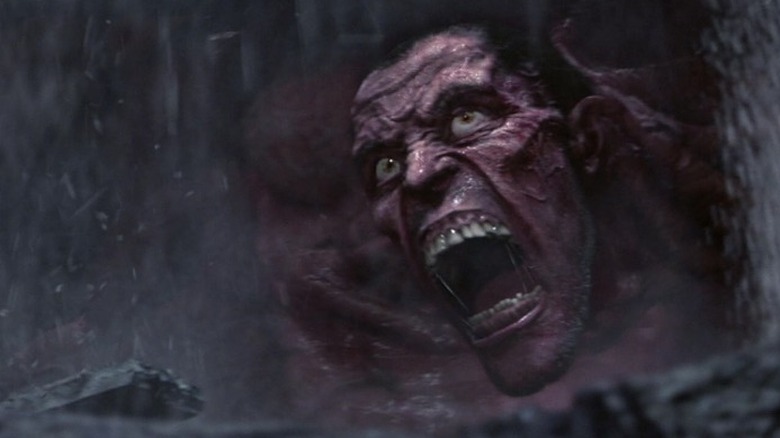The Worst CGI Moments In Superhero Movies
Today's boom in superhero movies can be traced directly back to the early 2000s, with the blockbuster success of films like "X-Men" and "Spider-Man." It was all in large part thanks to improvements in CGI, which allowed filmmakers to tell bigger, more fanciful stories about high-flying heroes and powerful supervillains. Today, comic book movies are their own unique genre, with superhero adventures arriving in cinemas practically every month. And none of them would be possible without the magic of computer-generated special effects.
But despite all of the incredible advancements in technology, even some of the most expensive superhero movies have dropped the ball. No matter how much money studios throw at the screen, not every moment stands up as a wonder of digital effects, and even some of the best superhero movies have some moments that make audiences cringe. Sometimes it's because the film got a little too ambitious, others it's a simple matter of not spending enough time to get it right (and with the increasing demands on VFX artists, it makes sense why). But which ones are the bottom of the barrel? From a blood-curdling vampire villain to a maddening multiverse mayhem, we've found the worst CGI moments in superhero movies.
Henry Cavill's mustache
While Marvel had already conquered the world with "The Avengers," rival DC struggled to play catch-up, and finally released "Justice League" in 2017. Unfortunately, the film was almost as much of a mess as its production, which saw a change in directors and massive reshoots. The most head-scratching moment, however, comes right at the beginning of the film, when Superman himself is awkwardly painted with CGI to remove an unfortunate mustache.
Arguably the most ridiculous behind-the-scenes incident in comic book movie history, "Justice League" star Henry Cavill had grown a big, bushy mustache for his next film, "Mission: Impossible Fallout," when replacement director Joss Whedon called the cast back for reshoots. But Paramount — the studio behind "Fallout" — wouldn't let the actor shave it off, and despite offering to pay for a CGI replacement on the Tom Cruise sequel, Warner Bros. was forced to do the opposite: Shoot new scenes with a mustachioed Henry Cavill, and use CGI to digitally shave it off.
Unfortunately, the effect isn't convincing at all, made worse by how quickly they had to do it. And it doesn't even stop with the opening scene: Throughout the film, reshoots are plainly obvious because Superman's CGI upper lip is so easily identifiable.
Blade's battle with Deacon Frost
One could make the very real argument that without the 1998 film "Blade," the entire genre of superhero movies as we know it might never have existed. Its success helped pave the way for the likes of "X-Men," "Spider-Man," and more, which of course led to the MCU, changing the landscape of modern film. But no matter what its ultimate legacy may be, "Blade" still has its share of rocky moments, and one of the sketchiest is the showdown between the sword-wielding hero and the vampire villain, Deacon Frost, thanks to some seriously wonky CGI.
Produced in the late '90s, "Blade" was made when CGI was still in its relative infancy, so it's not really surprising that it doesn't hold up. But good CGI in its day could still be convincing, as evidenced by early blockbusters like "Jurassic Park," the problem is that "Blade" bites off a little more than it can chew. As a result, the fight scene is full of awkward CGI, starting with fake sparks as the characters' swords clash. It escalates to a fake hand slice, and crescendos with the film's silliest moment, where Frost's body is cleaved in two. A mass of unmistakable CGI blood pours out, and Frost's separated torso laughably lands back on his legs as if nothing happened.
Black Adam's weird head
"Black Adam" was first announced way back in 2007, but it took 15 years for the film to reach the screen. One benefit of that long wait, though, was the incredible leaps in technology that took place over the years. And with a mammoth budget exceeding $200 million, fans could be assured that if nothing else, the film would boast the best visual effects that the genre could achieve. Or so they may have thought, because despite all it had on its side, "Black Adam" still managed at least one moment of bad CGI.
Like "Captain America: The First Avenger," the movie features a sequence from before its hero gained his incredible powers, and uses digital trickery to make the muscle-bound actor appear smaller. But while the composite of Chris Evans and a much slighter body double worked flawlessly in the 2011 Marvel movie, there's something not quite right about Dwayne Johnson's bulbous head on a more average person's body. Whether it's the weird proportions or the long neck, it's as simple as the CGI itself not being up to snuff ... there's a distracting uncanny valley element that makes the Rock's head stick out like a sore thumb. Sometimes literally.
Black Panther's final fight
Since Marvel Studios released its first movie in 2008, they've been heaped with accolades for their visual effects work. This includes 13 Academy Award nominations for best VFX, including on their very first effort "Iron Man" and their 2018 epic, "Avengers: Infinity War." One film that wasn't given the nod, however, was "Black Panther," which, despite earning itself a best picture nomination, was roundly roasted for some lackluster CGI moments. While many have harped on the infamous rhino scene during the climactic battle, it's the confrontation between hero and villain that earns a place on our list.
It all takes place in an underground subway tunnel beneath the city of Wakanda, where sonically guided trains are whizzing to and fro. There, T'Challa (Chadwick Boseman) — suited up as the Black Panther — confronts his rival Erik Killmonger (Michael B. Jordan) in a hand-to-hand fight to the death. The only problem is that the entire showdown is CGI, and it looks it, too, with character models that seem straight out of a Pixar film. The stiff, lifeless choreography never rises above the quality of a video game cut scene, and when their human faces are revealed, it only gets cringier.
Wolverine's fake claws
For the first three "X-Men" movies, Hugh Jackman used real physical props to create the iconic Wolverine claws, but when it came time for a spin-off movie, they went a different route. While the previous films had used CGI for certain moments — such as when Wolverine stabs, for instance – "X-Men Origins: Wolverine" opted to do away with the props entirely, and created the adamantium slicers completely in CGI. The effect, however, was less than convincing, with the computer-generated claws looking weightless and downright silly at times, particularly in the scene where he inspects them in a mirror.
The poor CGI used for Wolverine's claws in "X-Men Origins: Wolverine" is all the more mind-boggling when one considers how metal was one of the first elements that CGI had nailed as early as the mid-1990s. In a way, it's actually somewhat impressive to see a film from 2009 get the relatively simple effect so disastrously wrong. The VFX elsewhere wasn't much better, either, and the film wound up being a low point for Jackman's time in the role. Thankfully, they learned from the CGI slip-up, and Wolverine's claws — whether practical or digital — looked far better in subsequent installments.
Green Lantern's costume
The MCU was well underway in 2011, barreling headlong towards "The Avengers," which was due a year later. But that same year, DC tried to start their own cinematic universe with the release of "The Green Lantern," which, like Marvel's "Iron Man," centered on a lesser-known, wise-cracking hero played by a charismatic leading man (Ryan Reynolds). The only problem was that when he suited up as his superhero alter ego, the effect wasn't nearly as convincing as Iron Man's armor.
For whatever reason, the filmmakers opted not to use a practical costume like every other hero, but an entirely CGI suit. Although it was intended to give the character an other-worldly, alien look to match the character's powers and origins, it ended up just looking silly. Reaction to the CGI costume was so bad that even Reynolds got in on the bashing, to the point of mocking the unconvincing effect in his 2016 film "Deadpool." Thankfully, when it came time for the actor to play another superhero, he got the practical suit he'd always wanted. "I love having the tactile, real deal, all the time," he told Screen Rant.
The Flash's multiverse cameos
The DCEU that began with "Man of Steel" in 2013 was already announced to be ending when "The Flash" landed in theaters, but it was still being framed as a mammoth tentpole blockbuster. And with a reported budget of $200 million dollars, audiences were left somewhat stunned by just how bad the visual effects in the film were, with plenty of embarrassing CGI moments.
The worst, however, might be the sequence where audiences are given a quick peek into various alternate realities. Not only does the sequence begin with some cringe-worthy CGI orbs that look like something out of a '90s educational film, but the CGI recreations of old DC movie universes look cartoonish at best. This includes digitally created representations of Adam West, Christopher Reeve, and Helen Slater, among others. Like hand-painted moving cardboard cut-outs, the sequence is jaw-droppingly awful.
To make matters worse, the CW crossover event "Crisis on Infinite Earths" already did a series of multiverse cameos better — and on a TV budget — mostly thanks to using actual actors, with cameos from Burt Ward, Robert Wuhl, Alan Ritchson, Tom Welling, Ashley Scott ... and even Ezra Miller.
Bruce's head in Infinity War
Even films with the best visual effects aren't always flawless. Case in point: Marvel's 2018 superhero team-up extravaganza, "Avengers: Infinity War," one of the best movies in the MCU, and earner of an Academy Award nomination for best visual effects. Though it didn't take home the trophy (losing out to the Neil Armstrong biopic "First Man"), it did feature plenty of stunning effects work, including the fully CG character of Thanos. Still, there was at least one moment that earns a spot on our list, and anyone who's seen it likely knows exactly which moment that was.
The film, which assembles just about every hero in the MCU at the time, puts Bruce Banner in the unfortunate role of armor-suited hero after he's unable to turn into his Hulk form. Ironically using Tony Stark's so-called "Hulk-Buster" suit, he battles Thanos' minions, and when Thor arrives to turn the tide, he pulls back his helmet for one of the film's funniest lines. But while audiences may have laughed at Mark Ruffalo telling the monstrous war dogs "You're so screwed now," they weren't as impressed by the CGI that allowed it to happen. Featuring a clumsy floating head that seemed hastily slapped into the suit of armor, it's left fans chuckling ever since for all the wrong reasons.
Hulk's fight with his father
Following the success of "X-Men" in 2000, and "Spider-Man" in 2002, Hollywood realized superheroes were the key to blockbuster success, and moved on to Marvel's next most famous hero, the Incredible Hulk. Enlisting the services of acclaimed director Ang Lee, they released "Hulk" in 2003, which finally put the character on the big screen. No longer was the Hulk a bodybuilder in green body paint, though: This was the 21st century, after all, and he was brought to the screen entirely with the magic of CGI.
Despite all the advancements in computer-generated effects since the early '90s, however, a digital Hulk may have been a bit too ambitious. Throughout the film, the Hulk's overly bloated form looks lumpy and often inconsistent, not to mention a sickly shade of bright green that doesn't work. From the much-ridiculed gamma dogs to the groan-worthy comic book frames, the film never really looks right, even beyond the Hulk. But the worst moment is at the climax of the film when Hulk takes on his own father, a version of the comic book villain The Absorbing Man. The underwater fight scene often feels more like a bad Saturday morning cartoon than a lavish, big-budget blockbuster.
Reed ties up the Thing
Certain superheroes inherently require more special effects than others. Well, "The Fantastic Four" doesn't have just one hero who requires extensive VFX — there are four of them. The first theatrically released big-screen treatment of the team arrived in 2005, and they got away with one by making the Thing a rubber suit. They still needed a lot of CGI for the Human Torch, though, and plenty of transitional FX for the Invisible Woman and her force fields whenever she used her powers. The trickiest, though, was Mr. Fantastic, a hero who could only have been achieved with CGI, and unfortunately, they didn't always get it right.
The hero's stretchy powers were used all over the film, and there are moments when it's not terrible, but there are few where it's done particularly well. The worst, though, is when Mr. McStretchy tries to tie up his friend Benjamin Grimm, because it highlights every flaw in the CGI, from the cartoonish-looking hands to the unconvincing weightlessness and awkward moments when it doesn't seem like the two characters are actually interacting. What made it all the more disappointing was that Pixar had just released "The Incredibles" a year earlier, and while it was a cartoon rather than live-action, it illustrated perfectly how a stretchy hero should really look in action — and Mr. Fantastic in "Fantastic Four" definitely didn't pass muster.
Spawn's cartoon cape
In the early '90s, Image Comics took the industry by storm, leading to a number of now-iconic titles, led primarily by Todd McFarlane's "Spawn." The story of a mercenary who is killed by an unknown assassin, only to be resurrected by the devil himself with demonic powers, the anti-hero fights crime in New York City while trying to hunt down his own killer. So popular was the comic book that it quickly led to a feature film, released in 1997 and starring Michael Jai White and Martin Sheen. But one of the character's most famous visual attributes was translated to the screen through CGI, and it wasn't quite what fans may have expected.
Spawn is adorned with a long red cape which, thanks to the stylish art of Todd McFarlane, could flow out further than was practical and seemingly had a mind of its own, and the film used CGI to bring it to life. But the wizards behind the scenes could only do so much, because the limits of computer graphics at the time stopped short of realistic moving fabric. As a result, the effect seems woefully out of place, particularly next to the practical, rubber muscle suit the character wears, and nobody ever seems believable when interacting with it. In the end, "Spawn" wasn't a very good film, and the bad CGI cape was just the tip of the iceberg.
Elektra's tattoo monster
Bad special effects are the least of the problems faced by "Elektra," the spin-off of 2003's "Daredevil" led by Jennifer Garner as the titular sai-wielding assassin. Rife with eye-rolling dialogue, nonsensical plot points, bad direction, and worse acting, there's not much that could have saved this one. But if the CGI has been top-notch, at least it could have looked good, and given fans a fun visual spectacle. Alas, the effects were a total letdown, exemplified perfectly by the CGI used to create the powers of the movie's villain.
That villain is Tudo Sokuto, affectionally referred to as "Tattoo," and played by Chris Ackerman. Covered in tattoos — hence the nickname — he has the power to turn his ink into living spirits that can attack his enemies. This includes a wolf and a serpent, and while it might seem like a fun idea on paper, in action it makes no sense, and the CGI used to create it is sorely lacking in believability. With primitive, cheap-looking morphs, the tattoos turn 3D, with an accompanying lens flare that makes it look like a bad Photoshop job.
Catwoman's stunts
When it comes to bad comic book movies, "Spawn" is hardly at the top of the list (or bottom, depending on how you look at it). Far more infamous is "Catwoman," the ill-advised Batman spin-off starring Halle Berry which, along with fellow flop "Elektra," set back the sub-genre of female superhero flicks by nearly 20 years. Sloppy CGI was a big reason why. And it's kind of a head-scratcher as to why the film decided to lean on CGI at all, particularly when the hero of the story is just a woman in a literal catsuit, climbing walls and using a whip to nab the baddies.
Nevertheless, necessary or not, CGI is exactly what the film relies on, using a computer-generated model of the actress to do everything from a sultry walk across a light pole to scaling buildings and flipping through the air. In hindsight, it's not even anything that a talented stunt double couldn't have done more convincingly — and probably cheaper, too — making it one of the most bewildering uses of CGI on this list. Worse than just confusing, though, the CGI never once fits into a scene, and doesn't make any movie-goer believe it's real even for a second, as the digital model of Halle Berry moves clumsily, like a toy being handled by a bad puppeteer.
Hyde and Dante in League of Extraordinary Gentleman
Still worse than "Catwoman" was the 2003 adaptation of Alan Moore's "League of Extraordinary Gentlemen." Noteworthy for being so awful it allegedly forced Sean Connery into retirement, the story took a mystery-thriller starring famous literary characters like Captain Nemo, the Invisible Man, and Mina Harker, and turned it into a miserable B-grade schlock-fest. A haphazard mélange of clashing ideas, the film was lambasted for being a nightmarish mess of nonsense, and completely wasting both a promising premise and its excellent source material.
To top it off were the sloppy CGI effects used throughout, which come to their zenith in the brawl between Mr. Hyde — one of the film's heroes — and Dante, a villain who uses a chemical to turn himself into a Hulk-like monstrosity. The problem here isn't just the bad digital effects, but also the wonky design of the villain's mutated form, which will draw more laughs than screams of horror. The fight itself, meanwhile, is just the two oversized characters trading punches for a few minutes, and it gets boring after a while, which only adds insult to considerable injury. One of many "what were they thinking" moments in a bad comic book movie.
